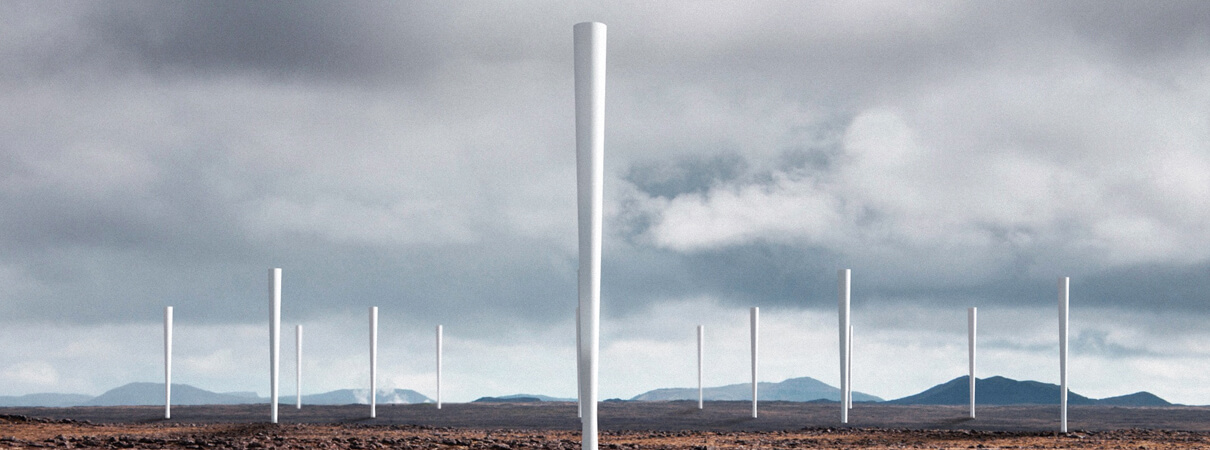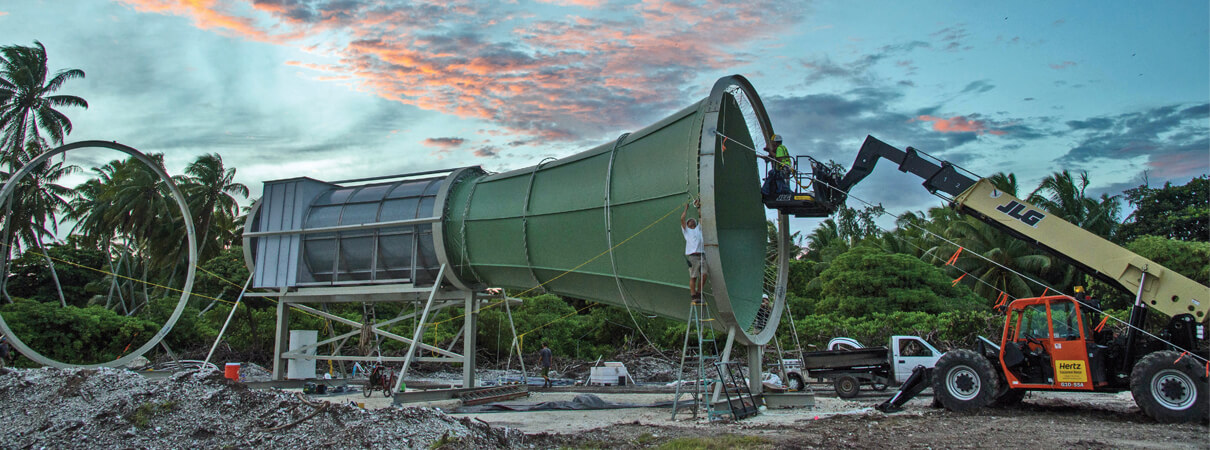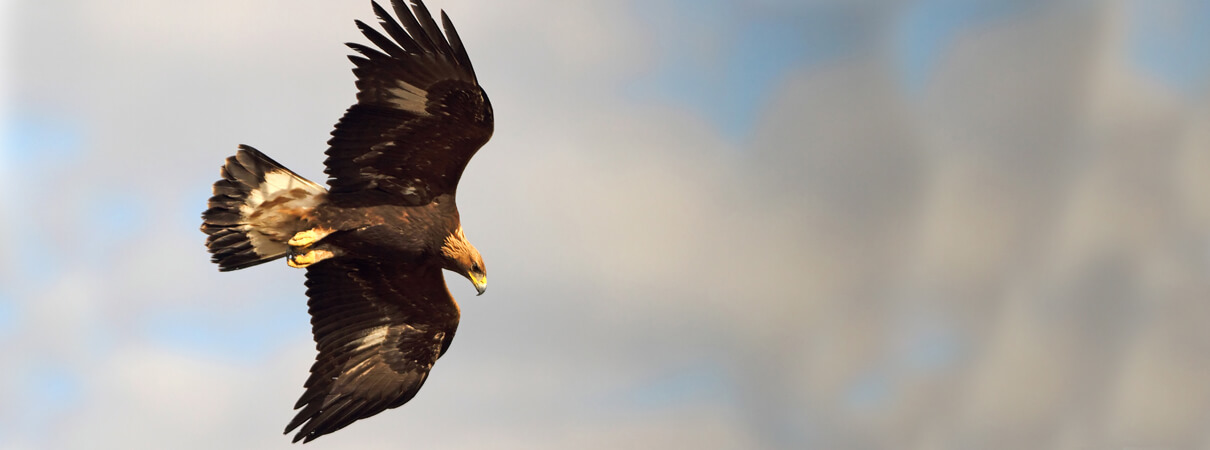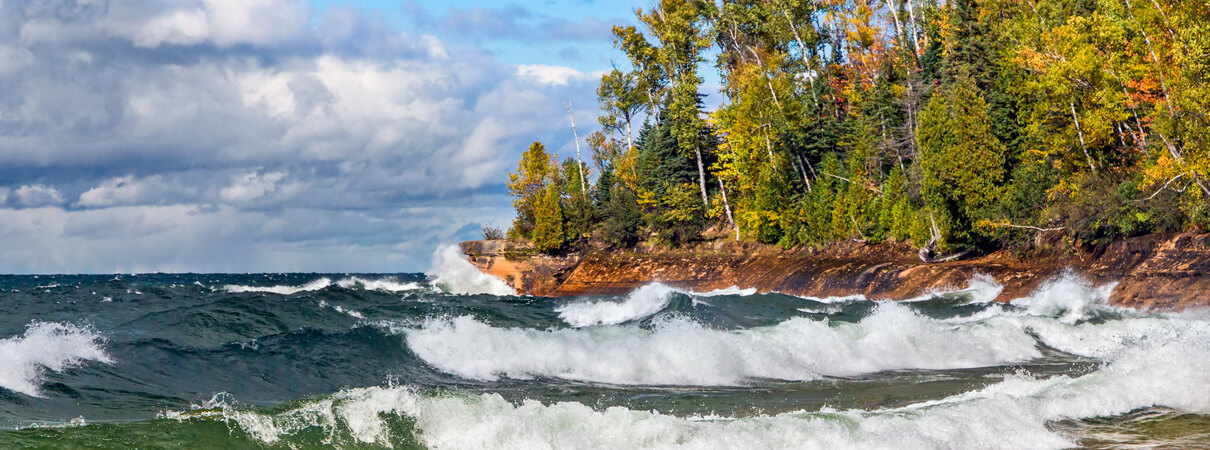Wind Energy And Birds FAQ — Part 2: Bird-Smart Wind Energy Solutions
ABC often receives questions about wind energy development and its impacts on birds and other wildlife. In this blog post — the second in a three-part series — Michael Hutchins, Director of ABC's Bird-Smart Wind Energy Campaign, answers some of the more frequently asked questions.
Read the first post in this series here: Understanding the Threat Wind Energy Poses to Birds. See a full list of references at the end of the post and stay tuned for the final post in this series.
Can wind energy be made safe for birds? What are some solutions?
Only proper risk assessment and siting can reduce or eliminate conflicts between birds and wind turbines. However, at present, this is not happening. The regulations that govern siting are weak at best, since even the U.S. Fish and Wildlife Service (USFWS) has stated that it does not have the authority to influence siting9.

New technology such as these bladeless wind turbines may be one way to implement bird-smart wind energy solutions. but will only be successful when the bladeless designs are shown to be as efficient as traditional wind turbine designs. Photo by Vortex Bladeless
Shutting down or reducing the use of turbine blades during periods of peak bird use of an area — such as migration — has also been effective in reducing mortality2. Such action greatly reduces the probability of collisions with the fast-moving blades, but this is not a popular solution for wind energy companies as it cuts into their profits. Radar can be used to detect large flocks of birds or bats coming into the area and then automatically shut down turbines, but these are expensive and are seldom used by industry17.
Wind industry companies hire their own consultants to conduct pre-construction risk assessments. This is a violation of the first principle of scientific integrity: Those that have a vested interest in the outcome, should not be collecting and interpreting the data. Indeed, there is a poor correlation between these pre-construction risk assessments and the number and types of birds killed post-construction7. Making matters even worse, federal permitting for wind energy projects is voluntary, not mandatory8.
There are ultimately only two ways that wind energy could be made relatively bird safe: adoption and enforcement of bird-smart wind energy principles by state, provincial, and federal regulators, and development of bladeless or enclosed-blade bird-friendly wind technology.
Many entrepreneurs are working on such designs, and many prototypes are in the testing stage. However, no design to date has been implemented on a large scale. This is unlikely to happen until these innovators can show that their designs are as efficient or at least close to the efficiency of a traditional wind turbine and that they are safe for birds16.
How do we implement these bird-smart wind energy solutions?
American Bird Conservancy is working to reduce the loss of birds from wind energy development by:
- working to strengthen state, provincial and federal regulations governing wind energy development;
- encouraging independent, scientifically-valid pre-construction risk assessments and planning to ensure that wind turbines stay out of sensitive areas for birds;
- opposing the worst-sited wind energy projects;
- encouraging the development, testing, and use of effective methods of mitigation;
- encouraging the enforcement of federal laws protecting wildlife, including the Migratory Bird Treaty Act, the Endangered Species Act, and the Bald and Golden Eagle Protection Act.
- fighting for scientific rigor and transparency in the collection and reporting of data about wind energy related bird and bat deaths;
- seeking compensation when public trust resources are taken; and
- educating the public and key decision makers about the dangers of poorly sited wind energy and power lines and towers.
(Learn more about ABC's approach to Bird-Smart Wind.)
Are there any current projects/sites that would be considered bird-smart wind energy solutions?
Unfortunately, the answer is “no.” Some wind energy developers have done more than others to protect birds and bats, such as SheerWind, but we know of no existing wind energy project in the United States or Canada that meets all of ABC's criteria for bird-smart wind energy development. The widespread lack of scientific integrity, independence, and transparency in the collection of pre-construction risk assessments and post-construction mortality data is especially problematic and worrisome11.

The enclosed-turbine technology developed by SheerWind may be one way to protect birds from the dangers of wind energy development. This installation is at the Army National Guard's Camp Grayling in Michigan. Photo courtesy Sheer Wind
How do we know if these bird-smart wind energy solutions are really better?
ABC is a science-based conservation organization, and we always base our policies on the best available scientific information. For example, a recent review article concluded that there are currently only two proven methods to mitigate or reduce bird kill by wind turbines: proper siting away from large concentrations of birds and curtailment of the turbine blades2. This suggests that ABC's focus on siting is appropriate, and it makes sense that keeping wind turbines away from large concentrations of birds will greatly reduce mortality.
Sign up for ABC's eNews to learn how you can help protect birds
ABC also believes in transparency and scientific integrity, something that is lacking in the wind industry today. We can't fully evaluate the impact of wind turbines and their associated power lines and towers, or the effectiveness of mitigation, unless mortality data are collected by independent, third-party experts who use standardized methods and report directly to regulatory agencies13. Right now, when it comes to wind energy development, the fox is watching the hen house1,6.
The same goes for risk assessments. At present, pre-construction risk assessments are conducted by paid consultants to the wind industry. These assessments are inherently biased and can be expected to have predetermined results. In fact, ABC has not reviewed one such study to date that has recommended against building a wind project due to risks to wildlife.
ABC also believes that our current wildlife protection laws should be enforced, which is often not happening when it comes to the wind industry5. Although there have been three recent prosecutions (Duke Energy: U.S. Dept. of Justice 2011; Laurel Mountain: Ward 2016; PacifiCorp: Goldberg 2014), virtually all wind energy facilities are violating the Migratory Bird Treaty Act, Bald and Golden Eagle Protection Act, and in some cases even the Endangered Species Act with impunity.
Doesn't the federal government already have wind energy regulations? Why aren't these enough?
Yes, the U.S. Fish and Wildlife Service has developed voluntary Land-Based Guidelines for Wind Energy Development8 and a revised eagle management rule9 that is intended to protect eagles from wind turbines. However, due to wind industry lobbying, these regulations have many weaknesses that limit their ability to protect our nation's birds from this rapidly growing threat.

SheerWind's Invelox technology funnels wind through hourglass-shaped tunnels that can stand vertically or—as with this half-built installation on the Palmyra Atoll—run horizontal to the ground. Photo by Cindy Coker
First, these regulations are voluntary, not mandatory. This means that wind developers are not required to go through an approval process, and many don't.
Second, the USFWS has stated that it has no ability to influence the siting of wind energy projects9, which is perhaps the most effective way of reducing bird and bat kill2. This has allowed for the construction of new turbines and associated infrastructure in areas that are known to be important for birds and bats4.
Last but not least, USFWS has been reluctant to enforce our nation's wildlife protection laws, including the Migratory Bird Treaty Act (MBTA) and the Bald and Golden Eagle Protection Act (BGEPA)5. Adding to that, state and provincial regulations are highly variable, with some having strong protections for wildlife (e.g., Hawai'i, Saskatchewan) and some having little or no regulation at all (e.g. Oklahoma).
The U.S. Fish and Wildlife Service released a new 30-year Eagle Take Rule. Can you explain what this is, how it helps, and whether it does enough?
The new 30-year Eagle Take Rule is a definite improvement over its predecessor, and some of these improvements are a direct result of ABC's successful lawsuit against U.S. Fish and Wildlife Service and the resulting National Environmental Policy Act (NEPA) process, tribal consultation, and public comment period.
First, eagle mortality data at permitted wind facilities will presumably now be collected by independent, third-party experts using standardized methods and reporting directly to USFWS. This will help to resolve the conflict-of-interest problem. Second, these data will be made available to the public. This change will greatly improve transparency and USFWS's access to accurate data on eagle mortality, which heretofore was a serious problem for wildlife managers.

The new USFWS 30-year Eagle Take Rule is an improvement over the previous rule, but still has room for improvement if it is to effectively protect eagles, such as this immature Golden Eagle. Photo by Jesus G. Gutierrez / Shutterstock
That being said, there are still problems with the rule. For example, rather than allowing for public oversight once every 5 years, the new 30-year permit will — in most cases — limit public involvement to a single time at the beginning of the 30-year permit period. This is highly problematic and may be in violation of the National Environmental Policy Act (NEPA). ABC believes the public needs to fully understand USFWS decisions about individual permits and why they are made. Thirty years is a long time, and much can happen during that time that could change the conditions of the initial permit.
The rule is also voluntary. ABC is also concerned that this will result in few wind energy developers seeking permits. Developers were not seeking permits under the old, five-year rule9, so why should they seek permits under the new 30-year rule, especially since it involves increased regulatory and public scrutiny?
The fate of the migratory Eastern Golden Eagle population — which only consists of a few hundred individuals — is a major concern. USFWS claims they will not issue take permits for the declining Golden Eagle population without mitigation, but a recent review showed that only two types of mitigation are effective in reducing bird kill: siting away from high concentrations of birds and curtailment of the turbine blades2. USFWS says it cannot influence the former, and the latter is unpopular with wind energy companies because it cuts into their profits.
Why is ABC fighting to keep large commercial wind projects away from the Great Lakes?
The Great Lakes are one of the worst possible places to be putting wind energy from the perspective of wildlife conservation. If any area in the United States and Canada should be avoided for wind energy development, it is the Great Lakes region, where we see one of the world's largest confluences of migratory birds and bats. The cumulative impact of the many existing and planned projects in the region could be substantial and cannot be evaluated on a case-by-case basis.

The Great Lakes — including Lake Michigan, pictured here — are of vital importance to many species of migratory birds. Wind development projects in the Great Lakes region could pose a significant threat to these birds, as well as resident waterfowl and other species. Photo by Kenneth Keifer / Shutterstock
During spring and fall, these large freshwater lakes pose a significant obstacle to birds and bats during their annual migration to and from Canada's boreal forests, where they breed. At this time, vast numbers of birds and bats, many of which migrate at night, gather along the shorelines and eventually fly along or over the lakes.
Three recent advanced radar studies conducted by the USFWS in Michigan, Ohio, and New York3,10,15, have confirmed the danger that large-scale wind energy development would pose to migratory birds and bats in this region. Every study concluded that vast numbers of birds are found along the lakeshore during spring and fall migration, and that many are flying within the rotor-swept areas of commercial wind turbines. This puts them at considerable risk of injury or death.
The interior of the Great Lakes is also important habitat for water birds. Lake Erie was recently designated a Globally Important Bird Area because of the vast numbers of water birds that use the lake at various times of the year. Some wind energy projects might impact the Great Lakes habitats used by water birds, and in some cases may impact habitats before we can determine their worth to birds and other species. For example, the proposed Horse Creek Project in New York would threaten an unusual limestone karst habitat that has yet to be thoroughly surveyed for its biodiversity.
Why is ABC concerned about wind energy development in Hawai'i?
There are two primary drivers behind ABC's concern about large-scale wind energy development in Hawai'i. First: Hawai'i has made a commitment to achieve 100 percent renewable energy by 204514. Second: The islands are home to many species of endemic birds, most of which are highly endangered and federally protected under the Endangered Species Act (ESA). Thus, unless wind energy is carefully placed it could pose a significant threat to the islands' rare and endemic wildlife. ABC has a strong interest in the conservation of endemic Hawaiian birds and is closely monitoring any planned wind development — both onshore and offshore — in the Archipelago.

Hawai'i is committed to achieving 100 percent of its energy from renewable sources by 2045, a goal that may spur the development of additional wind turbines on the islands. The state has also made some areas totally off limits to wind development, including the entire island of Kauai, pictured here. Photo by Milan van Weelden / Shutterstock
Fortunately, Hawai'i also has some of the strongest wind energy regulations in the United States12. Unlike elsewhere in the country, the state of Hawai'i and USFWS require that all Hawaiian wind projects develop a Habitat Conservation Plan and fully assess all possible impacts. Furthermore, the state has made some areas totally off limits to wind development. For example, no wind energy projects will be permitted on the island of Kauai, which is home to many endangered species. Finally, Hawai'i requires that post-construction mortality data be collected by third-party, independent experts using standardized methods, and that these data are then made available to the public and concerned conservation organizations on request.
So, Hawai'i has a good structure in place. Our role is primarily to provide oversight, which is important to ensure that protocols are followed and scientific results are heeded.
What do you see as the next step for making wind energy safer for birds?
There are many things we would like to see happen in the next few years to make wind energy safer for birds and bats. However, this is an uphill battle because wind energy developers have done a very good job of promoting themselves as a “green” alternative to fossil fuels. Furthermore, these are multi-million dollar businesses that can afford high-paid lobbyists and thus have the ears of government officials. The fact is, wind energy is just another form of for-profit energy development that has environmental impacts, especially when it is poorly sited and regulated. It is critical that it be closely watched and better regulated.
ABC would like to see:
- bird-smart principles adopted as we move toward renewable energy development;
- permitting processes that are mandatory, not voluntary;
- national or regional studies conducted that identify areas where wind energy should not be developed due to its potential impacts on federally protected wildlife and their habitats;
- pre-construction risk assessments and post-construction monitoring of bird and bat fatalities conducted by independent, third-party experts using standardized methods, followed by the sharing of these results in a manner that is transparent, open to the public, and transmitted directly to regulatory agencies;
- testing of the efficacy of various mitigation techniques, leading to best practices; and
- movement by the wind industry toward bird- and bat-friendly bladeless or enclosed blade technologies to replace the current bladed turbines.
Before wind energy projects are approved, other viable and less damaging alternatives, such as distributed solar on our already built environment, should be seriously considered.
Editor's note: Learn more about Bird-Smart wind energy, and look for the next installment in our wind energy FAQ series for more information.

Michael Hutchins, Director of American Bird Conservancy's Bird-Smart Wind Energy Campaign, earned his Ph.D. in animal behavior at the University of Washington. Prior to ABC, Michael was Director/William Conway Endowed Chair, Department of Conservation and Science, at the Association of Zoos and Aquariums for 15 years, and Executive Director/CEO at The Wildlife Society for seven years. He has authored over 220 articles and books on various topics in wildlife science, management, and conservation, and has traveled to over 30 countries to pursue his passion for conservation.
References:
- ABC 2015. Bird conservation group calls for changes in collection of data at wind developments.
- Arnett, E.B. and May, R.F. 2016. Mitigating wind energy impacts on wildlife: Approaches for multiple taxa. Human-Wildlife Interactions 19: 28-41.
- Bowden, T. S., E. C. Olson, N. A. Rathbun, D. C. Nolfi, R. L. Horton, D. J. Larson, and J. C. Gosse. 2015. Great Lakes Avian Radar Technical Report Huron and Oceana Counties, Michigan. U.S. Department of Interior, Fish and Wildlife Service, Biological Technical Publication FWS/BTP-2015.
- Casey, M. 2015. 30,000 wind turbines located in sensitive areas for birds. CBSNews.com.
- Clarke, C. 2014a. There is a problem with Fish and Wildlife's enforcement of bird law. KCET
- Clarke, C. 2014b. It's time for independent monitoring of wildlife kills at renewable energy sites. KCET.
- Ferrer, M., de Lucas, M., Janss, G.F., Casado, E., Munoz, A.R., Bechard, M.J., and Calaqbuig, C.P. 2011. Weak relationship between risk assessment studies and recorded mortality in wind farms. Journal of Applied Ecology 49: 38-46.
- FWS 2012. U.S. Fish and Wildlife Service Land-based Wind Energy Guidelines. Washington, DC: U.S. Fish and Wildlife Service.
- FWS. 2016. Draft Programmatic Environmental Impact Statement for the Eagle Rule Revision. Washington, DC: U.S. Fish and Wildlife Service.
- Horton, R., Rathbun, N., Bowden, T., Nolfi, D., Olson, E., Larson, D.J., and Gosse, J.C. 2016. Great lakes Radar technical Report Lake Erie Shoreline: Erie County, Ohio and Erie County, Pennsylvania, Spring 2012. U.S. Department of the Interior, Fish and Wildlife service, Biological technical Publication FWS/BTP-R3012-2016.
- Hutchins, M., Parr, M. and Schroeder, D. 2016. ABC's bird smart wind energy campaign: protecting birds from poorly sited wind energy development. Human Wildlife Interactions 10 (1): 71-80.
- Hutchins, M. 2016. To protect birds from wind turbines, Look to Hawai‘i's approach. Bird Calls blog.
- Johnson, D. H., Loss, S. R., Smallwood, K. S, and Erickson, W. P. 2016. Avian fatalities at wind energy facilities in North America: Acomparison of recent approaches. Human-Wildlife Interactions 10(1): 7-18.
- Magill, B. 2015. Hawaii aims for 100 percent renewable power by 2045. Scientific American, Climate Central.
- Rathbun N. A., T. S. Bowden, R. L. Horton, D. C. Nolfi, E. C. Olson, D. J. Larson, and J. C. Gosse. 2016. Great Lakes Avian Radar Technical Report; Niagara, Genesee, Wayne, and Jefferson Counties, New York; Spring 2013. U.S. Department of Interior, Fish and Wildlife Service, Biological Technical Publication FWS/BTP-301 2016
- Sander, L. 2017. The new face of wind energy? Bird Conservation Winter/Spring 2016-17: 10-14.
- Scaglione, S. and Raftery, M. 2012. Using radar to control wind turbines and reduce bird kills: Does it work? East County Magazine.


















































